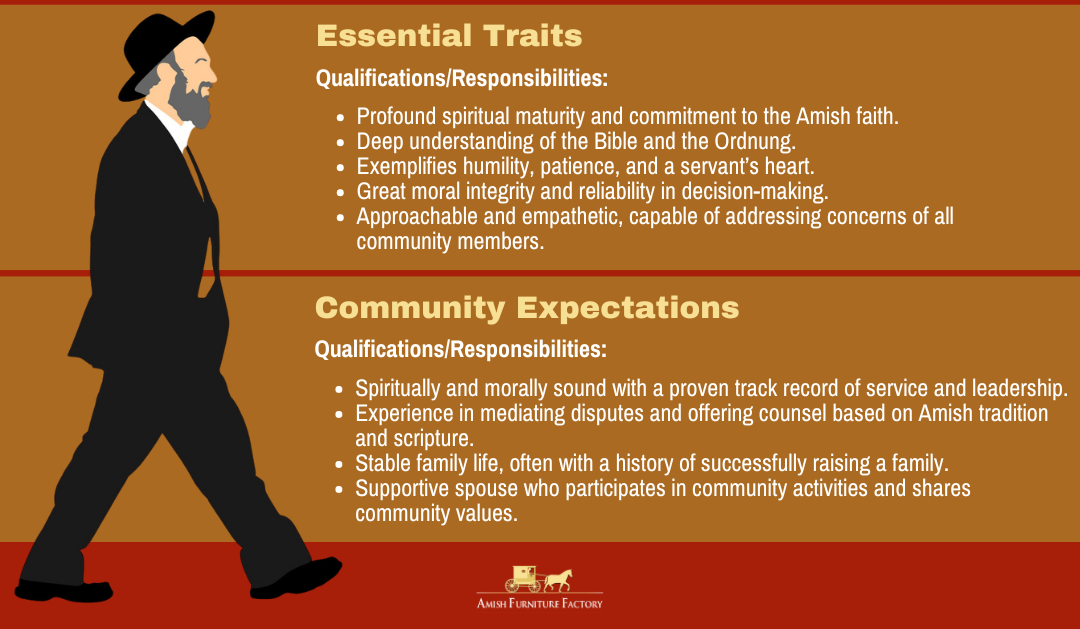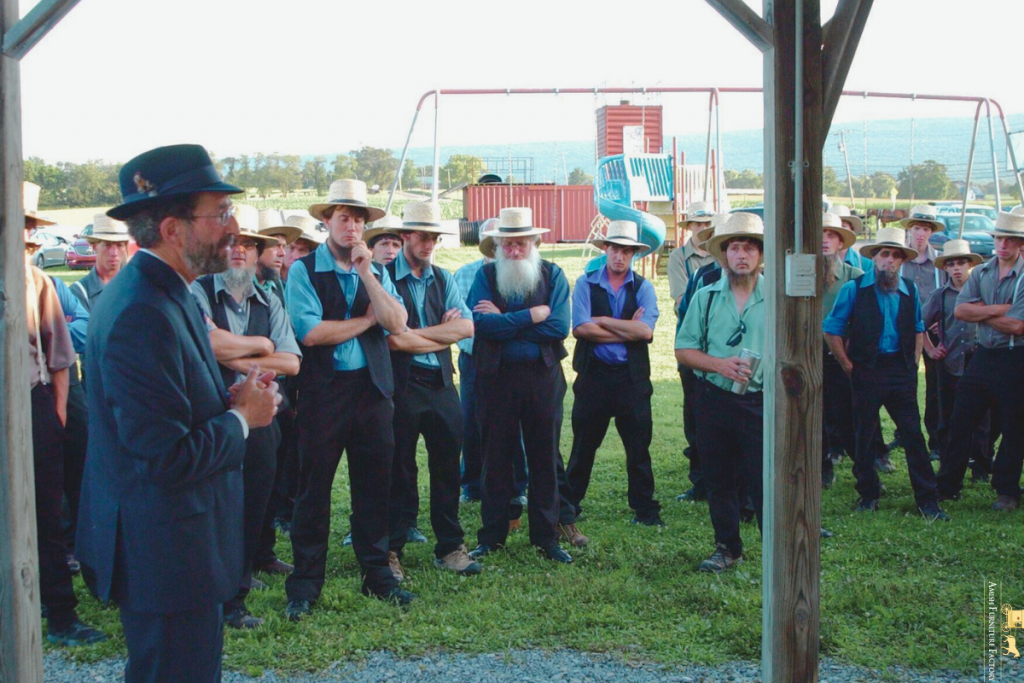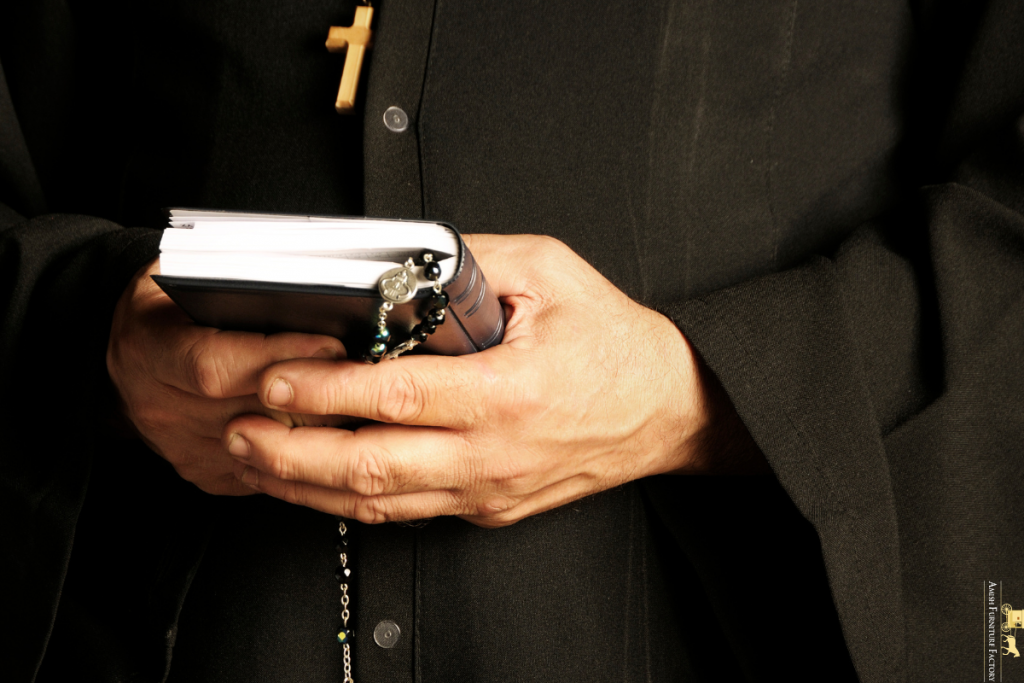
In the heart of the Amish community, the role of the bishop stands as a vital link between deep-rooted traditions and the day-to-day life of the people. These leaders do more than conduct religious services; they shape the community’s future while preserving its cherished past.
Key Takeaways
- An Amish bishop is a key religious leader within the Amish community, responsible for the spiritual guidance and governance of their congregation.
- The life of an Amish bishop is deeply intertwined with the spiritual, social, and practical aspects of the Amish community.
- From the community’s perspective, a bishop should not only be spiritually and morally sound but also have a proven track record of service and leadership within the community.
- The bishop selection process combines traditional methods with a reliance on what they believe is God’s will in the selection.
This article explores the intricate journey to becoming a bishop, the profound responsibilities that come with the role, and the lasting impact these leaders have on their community. Join us as we uncover the layers of commitment, leadership, and influence that define the Amish bishop.
Who is an Amish Bishop?
An Amish bishop is a key religious leader within the Amish community, responsible for the spiritual guidance and governance of their congregation. The bishop holds a significant role in maintaining the church’s traditions, overseeing religious ceremonies, and providing counsel to members.
The role of a bishop within the Amish community has its origins in the broader Anabaptist movement of the 16th century. The Amish themselves are a subgroup that split from the Swiss Anabaptists in the late 17th century under the leadership of Jakob Ammann. Here’s a historical overview and context of the bishop’s role:
Anabaptist Beginnings
The Anabaptist movement began in the early 16th century as part of the Radical Reformation, which sought to restore the practices and beliefs of early Christianity. Key tenets included adult baptism, nonviolence, and a strict separation from state affairs.
Early Anabaptist communities were organized with a structure that included ministers, deacons, and bishops. Bishops had a significant role in overseeing multiple congregations and ensuring doctrinal consistency.
Formation of the Amish

In the late 17th century, Jakob Ammann, a Swiss Anabaptist leader, argued for stricter adherence to religious practices and greater church discipline. His followers, known as Amish, split from the Swiss Brethren (later known as Mennonites) around 1693.
Following the split, the Amish retained the Anabaptist organizational structure, including the role of bishops. The bishop became a central figure in maintaining the distinct identity and practices of the Amish community.
Duties and Responsibilities of an Amish Bishop
The life of an Amish bishop is deeply intertwined with the spiritual, social, and practical aspects of the Amish community. Their routine reflects their responsibilities as religious leaders and their commitment to living a life that exemplifies Amish values.
An Amish bishop does not hold political power in the conventional sense, as the Amish community generally remains separate from secular governance and political activities.
Instead, bishops hold significant spiritual and community leadership roles, being highly respected within their communities. Their authority is the highest within their own districts, but it is primarily spiritual and communal, not political.
Here’s an overview of the typical life and daily routine of an Amish bishop:
Daily Responsibilities and Routine
Like most Amish people, a bishop starts the day early, typically before dawn. The bishop begins the day with personal prayer and Bible reading, seeking guidance and strength for the day’s tasks. Family worship and breakfast follow, reinforcing the spiritual foundation of the household.
Work and Community Engagement
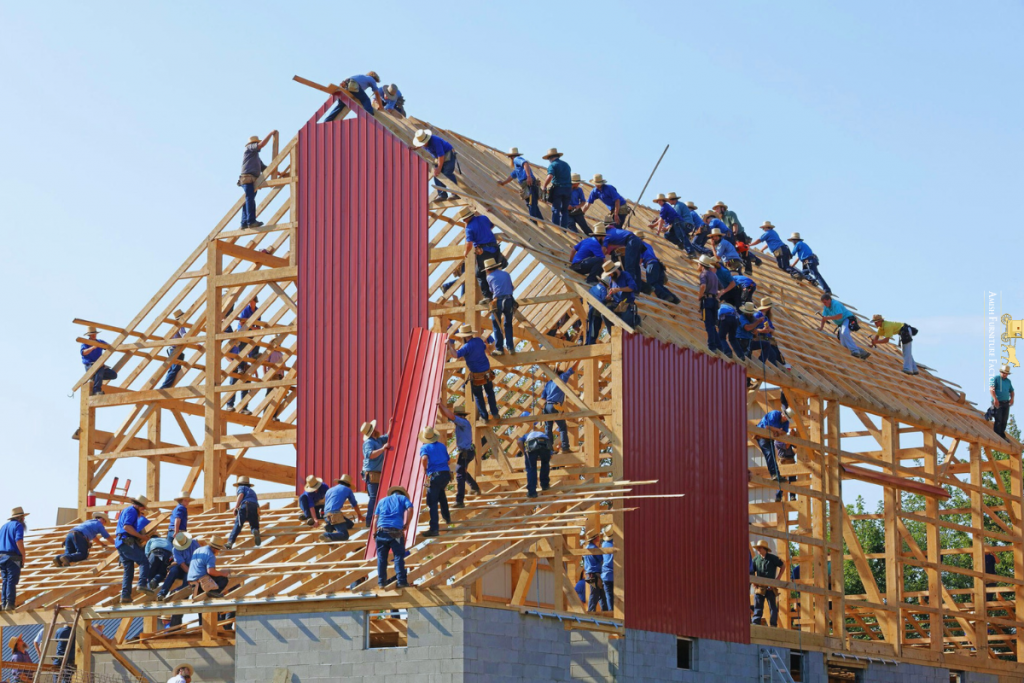
Bishops often have regular jobs, such as farming, carpentry, or other trades, similar to other Amish men. This work helps support their families and keeps them connected to the daily life of the community.
Throughout the day, the bishop may visit community members, offering spiritual counsel, checking on the sick or elderly, and providing support where needed.
Religious Duties
The bishop handles administrative duties, including organizing church services, preparing for communion, and maintaining church records. He may have meetings with other church leaders (ministers and deacons) to discuss church matters, plan events, and address any community issues.
Counseling and Conflict Resolution
The bishop spends significant time providing pastoral care, listening to the concerns of community members, and offering guidance based on Biblical principles. He mediates conflicts within the community, helping to resolve disputes in accordance with Amish teachings and the Ordnung (church rules).
Evening Activities
Evenings might involve attending or leading community events, such as hymn sings, youth gatherings, or special church meetings. The bishop ensures he spends quality time with his family, reinforcing the importance of family bonds and values.
Weekly and Monthly Responsibilities
Sunday Services
Every other Sunday (since Amish services are typically held biweekly), the bishop leads the worship service, delivers sermons, and administers the sacraments. He performs baptisms and officiates weddings, significant milestones in the lives of community members.
Communion Services
Twice a year, the bishop oversees the preparation and conduct of communion services, a key event in the Amish religious calendar.
Ordination and Leadership Training
When needed, the bishop leads the ordination process for new ministers and deacons, ensuring the continuity of spiritual leadership within the community.
Seasonal and Occasional Duties
Church District Oversight
Depending on the size of the Amish settlement, the bishop may oversee several church districts, requiring travel and coordination between them.
Church Discipline
The bishop enforces church discipline, including shunning for serious breaches of the Ordnung, and works towards reconciliation and restoration of members.
Qualifications and Characteristics
Understanding what makes an Amish bishop effective requires knowing both the inherent traits he should possess and the expectations the community has for this role. These characteristics ensure that he can lead with wisdom and integrity.
Essential Traits for an Amish Bishop
An Amish bishop must exhibit a profound level of spiritual maturity and commitment to the Amish faith. This includes a deep understanding of the Bible and the Ordnung, the set of rules governing Amish life.

His life should exemplify humility, patience, and a servant’s heart, as these qualities are essential for leading a community that values simplicity and modesty above all.
Moreover, a bishop needs to be a person of great moral integrity and someone who can be relied upon to make decisions that benefit the whole community, not just a few individuals. He must be approachable and empathetic, capable of understanding and addressing the concerns of all community members, from the young to the elderly.
Community Expectations and Qualifications
From the community’s perspective, a bishop should not only be spiritually and morally sound but also have a proven track record of service and leadership within the community. This includes experience in mediating disputes and offering wise counsel based on a thorough knowledge of Amish tradition and scripture.
Additionally, the community expects a bishop to be a stable family man, often preferring candidates who have successfully raised their own families. This personal aspect of his life is seen as a testament to his ability to lead and nurture the larger community family.
Having a supportive spouse also plays a critical role, as she will be involved in many community activities and needs to embody the same values and virtues.
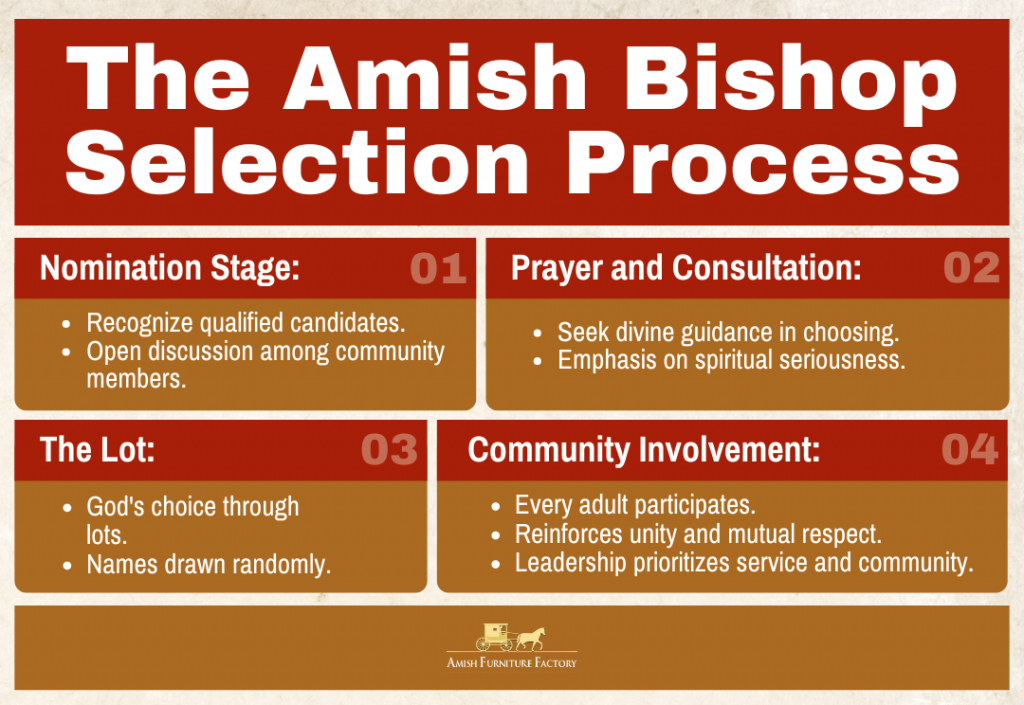
The Selection Process
Choosing an Amish bishop is a distinctive and deeply spiritual process that reflects the community’s values and its commitment to divine guidance. This process combines traditional methods with a reliance on what they believe is God’s will in the selection.
Nomination Stage
The nomination stage begins with the community recognizing potential candidates who meet the necessary spiritual, moral, and practical qualifications. Eligibility often depends on the individual’s standing within the community, their knowledge of the scriptures, and their previous contributions to the community’s well-being.
It’s a time for careful consideration, where the merits and virtues of each candidate are discussed openly among community members.
Once potential bishops are nominated, the community engages in a period of prayer and consultation, seeking divine guidance in their choices. This stage is crucial as it sets the tone for the selection process, emphasizing the spiritual seriousness with which the community approaches the decision.
The Lot
Following nominations, the Amish employ a method called “the lot,” which they believe allows God to determine who should become the bishop. This practice is based on the biblical tradition seen in Acts 1:26, where the apostles used lots to select a replacement for Judas. Candidates’ names are placed into a book or a hat, and one is randomly drawn, often by a child.
This method underscores the Amish belief in divine providence — that God’s will is paramount in guiding their decisions. The community views the outcome of the lot as God’s clear choice, eliminating personal biases and ensuring that the selection is not influenced by human preference.
Community Involvement
Community involvement does not end with the nomination or the lot. Throughout the process, every baptized adult member of the church is involved in some way, whether through discussing candidates, praying, or participating in the selection meetings. This extensive involvement ensures that the chosen bishop genuinely represents the will and needs of the entire community.
Moreover, this collective participation reinforces community bonds and demonstrates a commitment to unity and mutual respect. It’s a profound expression of their values in action, showing that leadership in the Amish community is not just about authority but about serving and reflecting the communal spirit.
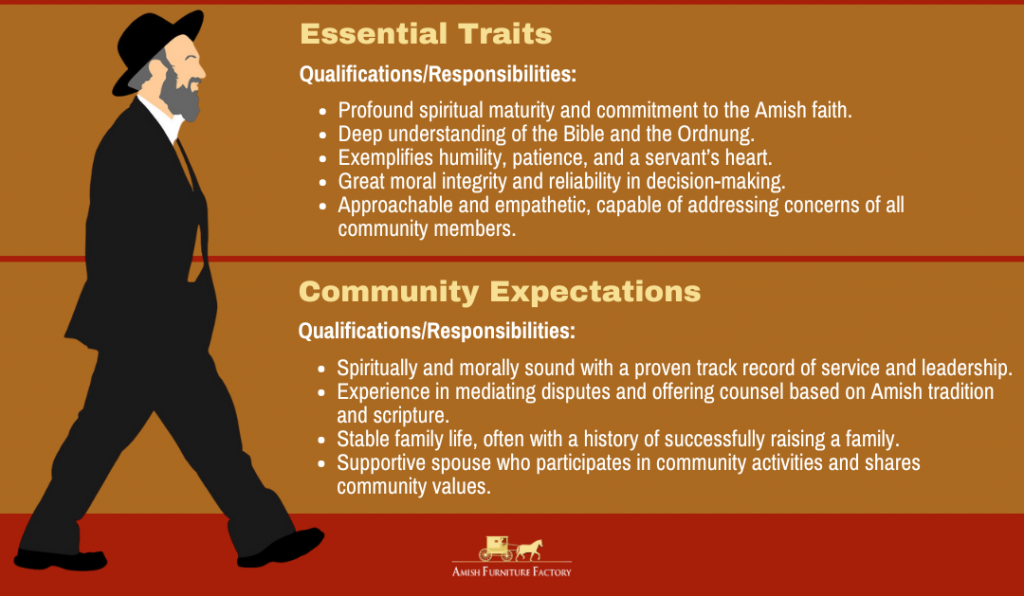
Post-Selection
Once a new Amish bishop has been chosen through the community-driven and spiritually guided selection process, the focus shifts to formally integrating him into his new role. This involves not only ordination but also ongoing training and mentoring to prepare him for the responsibilities he will shoulder.
Ordination
Ordination is the ceremony that officially marks the beginning of a bishop’s service in the community. It’s a solemn and significant event attended by the whole community, where the new bishop is blessed and entrusted with his duties.
During the ceremony, senior bishops lay hands on the newly selected bishop, praying over him and invoking God’s guidance. This act symbolizes the transfer of spiritual authority and the community’s trust in his leadership.
Training and Mentoring
After ordination, the new bishop undergoes a period of training and mentoring under the guidance of more experienced bishops. This phase is crucial as it helps him understand the deeper nuances of managing community affairs, resolving conflicts, and maintaining spiritual oversight.
The mentoring also includes practical advice on conducting services, counseling members, and handling the administrative duties that come with his role. This preparation ensures that he is well-equipped to lead his community with wisdom and compassion.
Challenges and Considerations
Becoming a bishop in the Amish community brings with it not only honor and responsibility but also significant challenges and considerations. These challenges require careful navigation to maintain the delicate balance between tradition and the evolving needs of the community.
Balancing Tradition and Modern Challenges
One of the primary challenges for an Amish bishop is maintaining the community’s traditions while addressing modern-day challenges. As the world changes around them, Amish communities occasionally face new social, economic, and technological pressures that test their traditional ways of life.
The bishop must lead his community in navigating these issues, deciding how to integrate new technologies or practices without compromising their core values and beliefs. This delicate balance demands not only wisdom but also a deep understanding of both Amish tradition and the modern world.
Furthermore, the bishop must also consider the younger generation’s perspectives, who might be more exposed to or curious about the world outside their community. He must find ways to address their questions and needs in a manner that keeps them engaged and faithful to their heritage.
Addressing Disputes and Ensuring Unity
Another significant challenge for an Amish bishop is resolving disputes within the community and ensuring ongoing unity. Conflicts might arise over land use, business dealings, or family matters, and the bishop’s role is to mediate these disputes fairly and effectively.
His approach must be one of impartiality and deep understanding, aimed at mending relationships rather than merely enforcing rules.
In doing so, the bishop must foster a spirit of forgiveness and reconciliation, encouraging community members to resolve their differences in a way that strengthens their bonds rather than weakening them.
This is vital for maintaining the peace and unity of the community, ensuring that it remains strong and cohesive despite the inevitable challenges it faces.
Notable Amish Bishops and Their Contributions
The role of an Amish bishop has historically been filled by individuals who are deeply respected within their communities, often chosen for their wisdom, humility, and dedication to the principles of the Amish faith.
Though the Amish generally shun the spotlight, preferring a quiet life of service, some bishops have made significant contributions that are recognized both within and outside their communities.
Jakob Ammann, from whom the Amish derive their name, was an influential bishop in the late 17th century. He advocated for stricter church disciplines, such as shunning and more frequent communion, which led to the split from the Swiss Brethren and established the Amish as a separate group.
Christian Yoder Sr., another early bishop, played a pivotal role in organizing the Amish community in Pennsylvania, helping to lay down the foundations for future generations in North America.
In more recent times, figures like Elmo Stoll have sought to return to stricter interpretations of Amish tradition. Stoll led a movement to establish the “Christian Communities,” emphasizing a return to fundamental practices and a conservative lifestyle.
Meanwhile, Moses M. Beachy led to the creation of the Beachy Amish Mennonite Fellowship, a group that integrates more progressive changes while still holding onto core Amish beliefs.
Wrapping Up: Reflecting on Tradition and Leadership
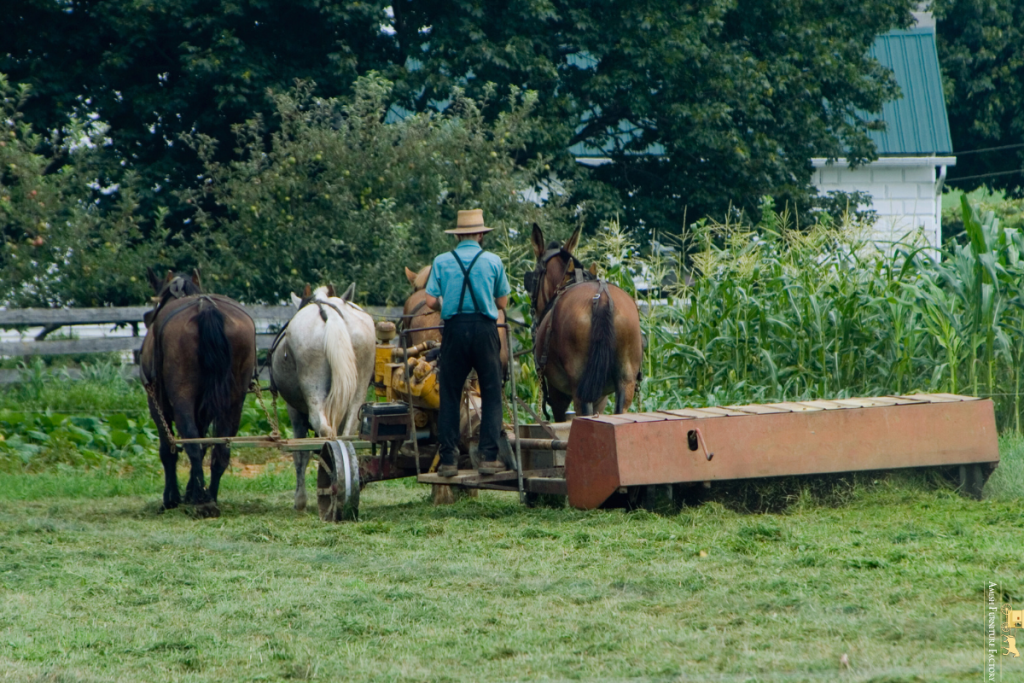
Amish bishops are pivotal, serving not just as religious leaders but as custodians who actively preserve and adapt the community’s traditions in the face of modern challenges. Their leadership is essential in sustaining the core values and continuity of the Amish way of life.
For those interested in Amish craftsmanship and values, a visit to the Amish Furniture Factory website provides a closer look at the quality and traditions upheld by the Amish community through their handcrafted furniture.
FAQs
How long does an Amish bishop serve?
An Amish bishop typically serves for life, reflecting the permanence and stability valued in the community. This lifelong commitment ensures continuity in leadership and deepens the bishop’s understanding of his community over time, allowing him to serve more effectively.
Can an Amish bishop be removed from their position?
It is highly unusual for an Amish bishop to be removed from his position. The Amish emphasize forgiveness and reconciliation, and any issues with a bishop’s leadership are usually resolved through community discussions and personal repentance.
However, in extreme cases where the bishop cannot fulfill his duties or acts contrary to Amish teachings, he might be asked to step down.
What happens if a bishop candidate declines the position?
If a bishop candidate declines the position after being selected by the lot, the community respects his decision, recognizing it as a sign of humility. The selection process would typically be repeated until a willing candidate is found.
This ensures that the person serving as bishop is fully prepared and willing to take on the responsibilities of this significant role.
